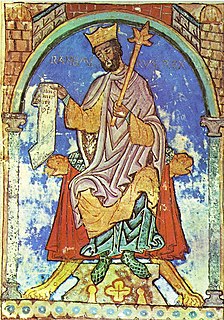
Alfonso XII was King of Spain, reigning from 1874 to 1885. After a revolution deposed his mother Isabella II from the throne in 1868, Alfonso studied in Austria and France. His mother abdicated in his favour in 1870, and he returned to Spain as king in 1874 following a military coup against the First Republic. Alfonso died aged 27 in 1885, and was succeeded by his unborn son, who became Alfonso XIII on his birth the following year.

The Reconquista is a name used in English to describe the period in the history of the Iberian Peninsula of about 780 years between the Umayyad conquest of Hispania in 711 and the fall of the Nasrid kingdom of Granada to the expanding Christian kingdoms in 1491. The completed conquest of Granada was the context of the Spanish voyages of discovery and conquest, and the Americas—the "New World"—ushered in the era of the Spanish and Portuguese colonial empires.

Ferdinand IV of Castile called the Summoned, was a King of Castile and León from 1295 until his death.
Alfonso VIII, called the Noble or the one of the Navas, was the King of Castile from 1158 to his death and King of Toledo. He is most remembered for his part in the Reconquista and the downfall of the Almohad Caliphate. After having suffered a great defeat with his own army at Alarcos against the Almohads in 1195, he led the coalition of Christian princes and foreign crusaders who broke the power of the Almohads in the Battle of Las Navas de Tolosa in 1212, an event which marked the arrival of a tide of Christian supremacy on the Iberian peninsula.

The Battle of Las Navas de Tolosa, known in Arab history as the Battle of Al-Uqab, took place on 16 July 1212 and was an important turning point in the Reconquista and in the medieval history of Spain. The Christian forces of King Alfonso VIII of Castile were joined by the armies of his rivals, Sancho VII of Navarre, Peter II of Aragon and Afonso II of Portugal, in battle against the Almohad Muslim rulers of the southern half of the Iberian Peninsula. The Caliph al-Nasir led the Almohad army, made up of people from the whole Almohad empire. Most of the men in the Almohad army came from the African side of the empire.
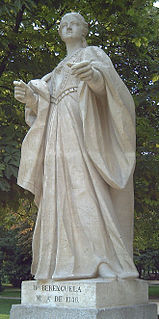
Berengaria was queen regnant of Castile in 1217 and queen consort of León from 1197 to 1204. As the eldest child and heir presumptive of Alfonso VIII of Castile, she was a sought after bride, and was engaged to Conrad, the son of Holy Roman Emperor Frederick I Barbarossa. After his death, she married her cousin, Alfonso IX of León, to secure the peace between him and her father. She had five children with him before their marriage was voided by Pope Innocent III.

Richard of Conisburgh, 3rd Earl of Cambridge was the second son of Edmund of Langley, 1st Duke of York, and Isabella of Castile. He was beheaded for his part in the Southampton Plot, a conspiracy against King Henry V. He was the father of Richard Plantagenet, 3rd Duke of York, and the grandfather of King Edward IV and King Richard III.

A military order is a chivalric order with military elements. Western military orders were originally established as Catholic religious societies; the first orders originated during the medieval Crusades with the stated purpose of protecting Christians against violent persecution by Islamic conquests in the Holy Land, which later evolved into serving as a standing army that defended the Kingdom of Jerusalem.
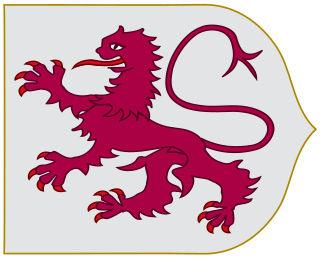
The Kingdom of León was an independent kingdom situated in the northwest region of the Iberian Peninsula. It was founded in AD 910 when the Christian princes of Asturias along the northern coast of the peninsula shifted their capital from Oviedo to the city of León. The County of Castile separated in 931, the County of Portugal separated to become the independent Kingdom of Portugal in 1139 and the eastern, inland part of León was joined to the Kingdom of Castile in 1230.
Santa Hermandad was a type of military peacekeeping association of armed individuals, which became characteristic of municipal life in medieval Spain, especially in Castile. Modern hermandades in Spain, some of which evolved from medieval origins, are now for the most part religious confraternities retaining only a military structure and ethos.
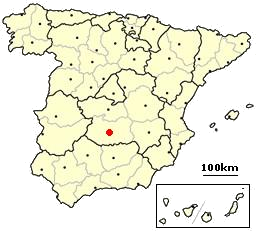
Battle of Alarcos, was a battle between the Almohads led by Abu Yusuf Ya'qub al-Mansur and King Alfonso VIII of Castile. It resulted in the defeat of the Castilian forces and their subsequent retreat to Toledo whereas the Almohads conquered back Trujillo, Montánchez and Talavera.

The Order of Alcántara, also called the Knights of St. Julian, was originally a military order of León, founded in 1166 and confirmed by Pope Alexander III in 1177.

The Siete Partidas or simply Partidas was a Castilian statutory code first compiled during the reign of Alfonso X of Castile (1252–1284), with the intent of establishing a uniform body of normative rules for the kingdom. The codified and compiled text was originally called the Libro de las Leyes. It was not until the 14th century that it was given its present name, referring to the number of sections into which it is divided.
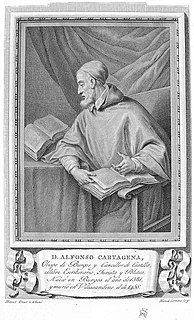
Alfonso de Santa María de Cartagena was a Jewish convert to Christianity, a Roman Catholic bishop, diplomat, historian and writer of pre-Renaissance Spain.

Roger de Flor, also known as Ruggero/Ruggiero da Fiore or Rutger von Blum or Ruggero Flores, was an Italian military adventurer and condottiere active in Aragonese Sicily, Italy, and the Byzantine Empire. He was the commander of the Great Catalan Company and held the title Count of Malta.
During the reconquista, the siege of Córdoba (1236) was a successful investment by the forces of Ferdinand III, king of Castile and León, marking the end of the Islamic rule over the city that had begun in 711.

The Torre de los Adalides was a rectangular medieval look-out tower of Islamic design located in the vicinity of Algeciras, Spain. It was situated roughly 1 kilometre (0.62 mi) from the coast on a hill some 100 metres (330 ft) above sea level in the area which is now covered by the city's northern suburbs. The tower was demolished by the Spaniards during the Spanish–American War as they thought the Americans might use it as a base of their own. The ruins of the tower are within military limits and cannot be approached without a formal permit.

The Admiral of the North and West or Admiral of the North and Western Fleets was a former senior appointment of the English Navy. The post holder was Commander-in-Chief of the English navy's North and Western Fleets operating in the North Sea, the English Channel, the Southern Irish Sea and Atlantic from 1364 to 1414.


